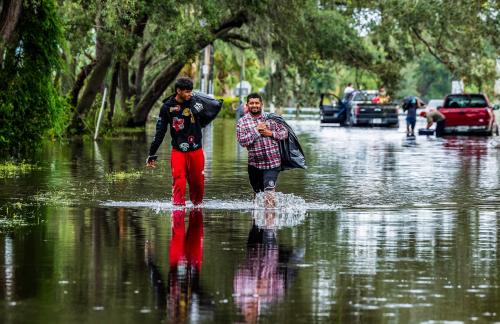During its halcyon legislative days in the 1970s, the public face of environmentalism was overwhelmingly white and middle class. Minority politicians provided reliable votes for environmental statutes but were often acutely suspicious of mainstream environmentalism, believing the urban poor a more endangered species than spotted owls. Whitney Young, executive director of the National Urban League, bluntly advised postponing the war on pollution until “after the war on poverty is won.”
Today, however, a national environmental justice movement dominated by people of color is aggressively demanding attention to pollutionþand to race, poverty, and apparent links between them. Sustained by a combination of research findings and widespread outrage among communities in toxic terror, the movement claims that a lack of power among poor and minority communities has saddled them with disproportionate burdens both in pollution and in environmental policy implementation.
In fits and starts, state governments are beginning to grapple with the issue. So is the Clinton administration, which in February 1994 issued executive order 12898 charging each cabinet department to “make achieving environmental justice part of its mission,” with the Environmental Protection Agency to lead the way. Having inherited an office of environmental equity from the Bush administration, EPA administrator Carol Browner renamed it the office of environmental justice, appointed a national environmental justice advisory council stocked heavily with advocates, and promoted strategic planning. Under assistant administrator Elliott P. Laws, EPA’s office of solid waste and emergency response (OSWER) has made environmental justice a top priority.
All this—the energizing of the movement, the community activism, the state and federal response—sounds promising and is certainly well-intended. But the environmentally just society is not just around the corner. Many hurdles lie between the status quo and a thoughtfully reformed regime of environmental policy, one that confers significant additional benefits on traditionally disadvantaged groups.
The Movement Problem
Ironically, one problem is the movement itself. An artfully nurtured “big tent” embracing black, Latino, Asian, and Native American grassroots organizations and their allies, the environmental justice movement began in earnest with a now legendary 1982 Warren County, North Carolina, protest against a proposed PCB landfill. Demonstrations failed to stop the landfill, but hundreds of protesters were arrested. A subsequent study of hazardous waste landfills in the southeast by the General Accounting Office found that blacks were a majority of the population in three of the four ‘off-site” (that is, not associated with an industrial facility) landfills in the region. As time went on, other communities, in tandem with scholar- activists like sociologist Robert Bullard, would coalesce into a movement challenging what they saw as an unmistakable and insidious tendency to make communities of color society’s dumping ground.
The problem the movement faces is crucial, and probably unavoidable. The movement has grown, and maintained internal harmony, through a blend of inclusiveness and ideological appeals that derails discussion of priorities and trade- offs. It tends therefore to avoid difficult but necessary decisions. For example, the notion of acceptable risk, basic to any realistic approach to health and safety, is suspect within the movement as an excuse for victimizing people of color. A “bottom-up” coalition for which all grievances are created equal is especially hard pressed to think in terms of the relative risks and costs of such environmental hazards as childhood lead and farm worker pesticide exposures, Superfund cleanups, incinerator sitings, or even non-environmental health hazards. The movement presumes that any person of color voicing any environmental-related anxiety or aspiration represents a genuine environmental justice problem. Indeed, a broader redistributive and cultural agenda, as well as a profound discomfort with industrial capitalism generally, lurks just behind the concerns over unequal pollution impacts. To some extent this isnþt really surprising. The same ethnic and neighborhood empowerment yearnings visible in “community action” a generation ago have remained with us all along, to resurface with an environmental spin.
Causal Problems
Through a blend of skillful grassroots mobilization, advocacy research, and well- crafted rhetoric, the environmental justice movement has placed its concerns on the national policy agenda. Although the full universe of empirical studies offers mixed support for the movement’s claim of racial disparities in the distribution of pollution, a 1994 National Wildlife Federation review of 64 highly diverse studies concluded that all but one “found environmental disparities either by race or income, regardless of the kind of environmental concern or the level of geographic specificity examined.” In 1987 the United Church of Christ’s Commission for Racial Justice, headed by Benjamin F. Chavis, Jr., released its report on Toxic Wastes and Race in the United States, finding that “communities with the greatest number of commercial hazardous waste facilities had the highest composition of racial and ethnic residents.”
But advocacy and research have not put to rest some tricky causal issues. If people of color indeed bear disproportionate environmental burdens, what role has government policy played in creating this state of affairs? What concrete health impacts follow from such burdens? And what ameliorative role can government policy plausibly play?
One complication lies in how one defines a burden. Proximity to an existing or potential site or facility may stimulate grassroots outrage but by itself says little about the degree of actual exposure or hazard posed. Because of variables such as groundwater dynamics and the quality of site construction or facility management, not all sites or facilities are equally dangerous. Experts agree that many of the 35,000 locations on EPA’s inventory of hazardous waste sites probably pose little risk.
Besides being unhelpful regarding the distribution of actual risk, the Commission for Racial Justice study is also unreliable as a guide to the distribution of the waste itself. By conning its focus to off-site hazardous waste facilities, it overlooks the vast majority (up to 96 percent) of hazardous waste processed on- site by the entity that generates it.
A 1994 update of the commission study touches on another problem. The proximity of people of color to commercial hazardous waste facilities (or, for that matter, any other kind of noxious site) may be due to forces over which government, particularly the federal government, has little influence. The update notes that “between 1980 and 1993, the concentration of people of color living in zip codes with commercial hazardous waste facilities increased from 25 percent to almost 31 percent of the average population around the facilities.” The study offers several possible explanations, “including the migration, birth, or death of individuals, and the relocation, start-up, or closure of toxic waste facilities.” To the extent that poor people reproduce more rapidly than wealthier ones or that low land values attract both poor people and industrial facilities, as is clearly the case, federal policy will be hard pressed to address the resulting inequities. It is particularly telling that this apparent increase has taken place in the post-Love Canal era, as all communities, including those of color, became both more willing and more able to block proposed facilities.
The health risks posed by environmental toxins are freighted with as much uncertainty as any public policy problem we face. On some matters (asbestos, say) we arguably have both abundant knowledge and something approaching expert consensus. On others our understanding is extremely limited and will probably never be definitive. EPA officials and environmental justice advocates often speak about grappling with the “multiple, cumulative, and synergistic risks” especially relevant to communities of color facing a variety of potential environmental and other health stresses at once and over time. For purposes of practical (and highly politicized) policy making on a community-by-community basis, though, the kind of knowledge envisioned may well amount to little more than a pot of gold at the end of the analytic rainbow. The reasons are obvious: a plethora of variables, insufficient command of their causal interrelationships, and mistrust of experts, especially should they produce findings that are either unsupportive of strongly held beliefs or riddled with ambiguity. Like the mainstream environmentalism it has often criticized as insensitive to minority perspectives, the environmental justice movement has little use for the skepticism about alleged health risks that a growing literature argues is sometimes warranted.
Environmental justice advocates assert, plausibly enough, that poor and minority areas are a magnet for environmental hazards in part because wealthier and whiter ones that are better able to defend their interests can shun them. But whatever may have been true in the past, these days minorities and whites alike often effectively marshal local outrage to play the “Not In My Backyard” (NIMBY) game. And the environmental racism argument, unlike critiques of conventional racial discrimination, posits disproportionate impact on minorities rather than a burden borne solely by them. Often a “minority area” is simply one with a “greater than average” percentage of minority residents. Since toxic air emissions, pesticide runoffs, and groundwater contamination cannot neatly select their victims by race or income, the inequities visited upon minorities affect a great many others as well. Indeed, the range of arguably significant environmental equity comparisons is so broad that some doubtless cut the other way: many Native Americans, for example, breathe cleaner air than urban Yuppies and live further from hazardous waste than New Jerseys white ethnics.
Themes of Justice
If science cannot lead us to the promised land, then perhaps politics and administration can at least get us part way there. After all, the environmental justice movement is less about the veritable health cards being dealt than about strong suspicions of a stacked deck.
Like the movement that inspired it, the Clinton administration’s executive order casts the broadest possible net, essentially instructing the executive branch to look hard for ways to identify and respond to any minority concerns and interests that are arguably environment-related. Such concerns and interests extend far beyond the allegations of siting inequity that were crucial to getting White House and media attention. Two years after the order’s promulgation, the basic outline of the government’s implementation effort has emerged. Apparent in planning efforts throughout the government, it embraces ve overlapping themes: participation, information, development, enforcement, and prevention. This mix reflects demands for local empowerment, the plethora of programs at which they are directed, and the menu of responses available (especially without new money or legislation). The movements bottom-up demands have yielded an analogous (albeit tentative and mostly low-prole) hodgepodge of agency-level process innovations.
A broad combination of outreach to, participation by, and information for communities of color forms the core of federal environmental justice empowerment efforts today. In theory at least, every department and large agency offers advisory panels and rulemaking or allocative processes that might be made more permeable to the voices and interests of disadvantaged minorities. EPA’s OSWER is pushing community advisory groups to “promote early, direct, and meaningful public involvement in the Superfund cleanup process.” Defense has advisory boards to expand community involvement in cleanup decisions at military bases. Health and Human Services offers funding for environmental risk communication and education in minority communities.
On the development front, OSWER is pursuing an ambitious initiative on urban “brownelds,” contaminated property often shunned by developers, banks, and insurers at least partly because of environmental concerns. Last July OSWER announced 15 cities that would each receive $200,000 in seed money to help nurture the return of brownelds to productive uses. OSWER’s efforts dovetail with Housing and Urban Development’s empowerment zones and enterprise communities program for directing community development funds to distressed areas.
There is also now tough talk from EPA about making enforcement more equitable. Current Supreme Court equal protection doctrine holds that plaintiff’s must prove intentional discrimination, but intent is often impossible to demonstrate successfully. As a potential avenue of redress for communities of color, EPA and the Department of Justice are showing considerable interest in Title VI of the 1964 Civil Rights Act, which provides that “No person in the United States shall, on the ground of race, color, or national origin, be excluded from participation in, be denied the benefits of, or be subjected to discrimination under any program or activity receiving federal financial assistance.” As Washington University Law Professor Richard Lazarus notes, “The principal advantage of Title VI over equal protection is that courts have not required a showing of discriminatory intent. . . . Disparate impact has been enough.” By last summer EPA was reviewing some two dozen petitions for redress under Title VI.
Pollution prevention is perhaps where environmental justice advocates find the easiest common ground with traditional environmentalists. Both see “green” technologies as a crucial weapon since preventing pollution obviates the need for distributing it equitably. And environmentalists have often viewed grassroots NIMBY activity that constrains treatment, storage, and disposal capacity as a weapon in the long-term war to force prevention. For these reasons, and because of significant successes in source reduction, it has been easy to recast ongoing prevention efforts as serving the cause of environmental justice.
Blunt and Fragile Instruments
To the extent that risk abatement and health improvements remain major environmental justice goals, emerging policies will prove blunt, or even irrelevant, instruments for their achievement. Brownelds redevelopment has little immediately to do with health. The director of environmental quality for the National Association of Manufacturers notes gamely that economic development will help improve health, because “the worst thing healthwise is to be poor.” But the brownelds sites themselves pose mostly minor health threats. Indeed, EPA’s ability to make the brownelds program work hinges on the relatively mild contamination at many sites and the relative ease with which the agency can lower, or at least clarify, future liability.
And while participation and outreach address the need for locally acceptable policies, they do not automatically assure that the most serious community health risks are given highest priority. What they may actually assure in some instances is that the loudest voices, the shrewdest or most diligent organizers, and the most obvious targets of local outrage will be elevated.
Nor is it by any means clear that environmental risks are always the most serious health risks that communities of color face. Hypertension, obesity, low birthweights, inadequate prenatal care, substance abuse, and violence are only some of the forces that arguably deserve pride of place in the struggle to improve the lives and health of communities of color. That such forces are more intractable and harder to mobilize around than a Superfund site or a proposed landfill must not deter communities from asking (and being vigorously encouraged by government policy makers and others to ask) hard questions about overall health priorities.
Federal environmental justice policy also remains extremely fragile in Washington. Even when Democrats controlled Congress during the first two years of the Clinton administration, environmental justice made little headway on Capitol Hill. In fashioning its largely doomed environmental agenda for the Democratic- controlled 103rd Congress, the administration left aside a tough bill proposed earlier by then Senator Al Gore. Gore’s bill ordered EPA to scrutinize human health in the 100 counties containing the highest total weight of toxic chemicals and, if adverse health effects were found, to impose a moratorium on future siting that compounded the problem. Analytic difficulties aside, such hard-edged federal restrictions were too politically explosive even among congressional Democrats, and the Clinton administration opted for a non-legislative approach to environmental justice.
The Republicans who control Capitol Hill today rally around environmental justice of a different sort. In the conservative lexicon, environmental injustice means excessive regulatory encroachment on private property rights. Even thriving EPA programs can never bear the full weight of the redistributive expectations of the environmental justice advocates, but in the current climate of attacks on EPA’s resources and authority, the vision of environmental justice favored by environmentalists and the grassroots Left faces a dire predicament indeed. Reassurances to the contrary notwithstanding, it will be hard for agency leaders to pay much sustained attention to environmental justice when they have more fundamental battles to fight.
An obvious confluence of business and community interests suggests that brownelds redevelopment could remain the high-prole pillar of federal environmental justice policy over the long run. Enterprise-minded conservatives, in alliance with Democrats anxious to help cities, might be able to rally behind it, especially if crafted to minimize its pork-barrel aspects (or, alternatively, to make the pork so tasty as to be irresistible to both parties). But no one familiar with the array of pitfalls that can bedevil the implementation of complex, well-intended policies should be shocked if, a decade or two hence, the very mention of “environmental justice” evokes a wince, a sigh, or a quiet shake of the head.
The Brookings Institution is committed to quality, independence, and impact.
We are supported by a diverse array of funders. In line with our values and policies, each Brookings publication represents the sole views of its author(s).



Commentary
A Winning Hand? The Uncertain Future of Environmental Justice
March 1, 1996